The real test of the EU’s energy freedom goals: sticking with the plan
Latest News
In the face of Russia’s invasion of Ukraine, European leaders have vowed to shed their dependence on Russian gas and charge full speed into tapping renewable energy.
The plan is there, the momentum is high and the potential is promising.
But how quickly and how decisively the European Union will follow through will be the fundamental test of this newfound political unity.
“We’re not standing here to say this is going to be in any way easy,” Frans Timmermans, the European Commission’s vice president, said last week. “Even if it’s going to be hard, it’s something we need to do because now it’s also intimately linked to our security.”
The EU’s biggest challenge will be to show it genuinely will change its energy habits after this crisis in a way it failed to do before—despite similar promises.
Putin has spurred in less than two weeks a historical U-turn in European foreign and energy policy axioms. Regrettably, it took a full-fledged Russian invasion of Ukraine for Europe to finally make up its mind and move forward.
But there are already signs it will be easier said than done.
Following a summit in Versailles, France, on Friday, EU leaders stated they want “to phase out our dependency on Russian gas, oil and coal imports as soon as possible.” But they failed to commit to a specific date—a testament of diverging views as to how quickly this can be done and how expensive it will be. The European Commission had proposed a deadline of 2027. It will present a detailed plan by the end of May with that deadline in mind.
In 2021, the EU imported 155 billion cubic meters of gas from Russia, more than 40% of what it uses. Total energy imports from Russia last year, which also include oil and coal, amounted to about €99 billion.
Bureaucrats have crunched the numbers to see how fast the bloc can wean itself from Russian gas and speed up its green energy transition. In guidance released last week, the European Commission said the EU can slash its dependency by two-thirds this year and to zero “well before 2030.”
In the short term, that means relying on more shipped liquefied natural gas from the United States or Qatar to diversify supplies. In the long term, it means speeding the uptake of renewable energy, including low-emission gases such as hydrogen, and increasing energy savings.
Most of these are already part of the EU’s ambitious European Green Deal, meant to cut the bloc’s greenhouse gas emissions to net zero by 2050. What’s significant are the tools this guidance gives EU countries to accelerate their implementation and to deal with potential disruptions in the short term.
The success of the EU’s green makeover won’t be measured today—and not via plans or in the hallways of EU institutions. It will be measured on the ground and over years and even decades after the crisis subsides.
What’s needed is a long-lasting political will to act that can percolate through the dense EU legislative machinery and clashing national interests down to the innovators, investors and regulatory agencies that can speed up permitting for solar and wind farms and beef up renovation efforts.
Lessons learned?
“EU energy policies (on renewable sources, greater efficiency, shale gas and interconnection of energy grids) could also play a role in reducing—if not completely eliminating—Europe’s dependence on Russian gas,” according to a European Parliament study.
It may read like it’s taking a page from today’s playbook, but the study is from October 2014, a few months after Russia annexed Crimea. Reducing reliance on Russian gas shot to the top of the agenda immediately after, especially through the 2015 Energy Union initiative.
As we previously reported the EU has increased, not decreased, its dependence on the fossil fuel from Moscow since then.
“It would be very good in politics if you could turn back time … and take better decisions than you’ve taken,” Timmermans said when asked if the Commission’s plan is not coming too late. “But we are where we are and now we need to move much quicker than we’ve done in the past to reduce our dependency on imports of energy from Russia.”
The good news is that the mass and speedy deployment of clean technologies today is much more realistic than it was eight years ago when the energy crisis left the EU scrambling.
“This last decade changed completely the technology landscape,” Tagliapietra said. “We didn’t have the solar and wind capacity of today, so today we can really deliver. That’s the big difference between now and then.”
He added: “In the longer term, Europe is likely to emerge from this crisis much greener than before.”